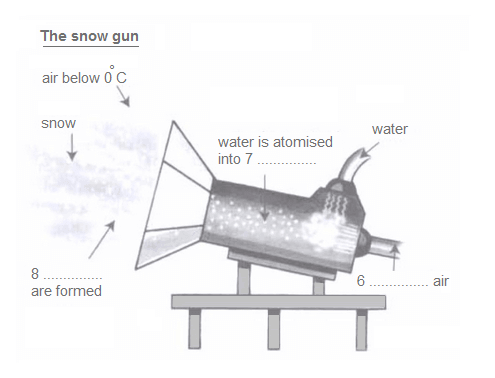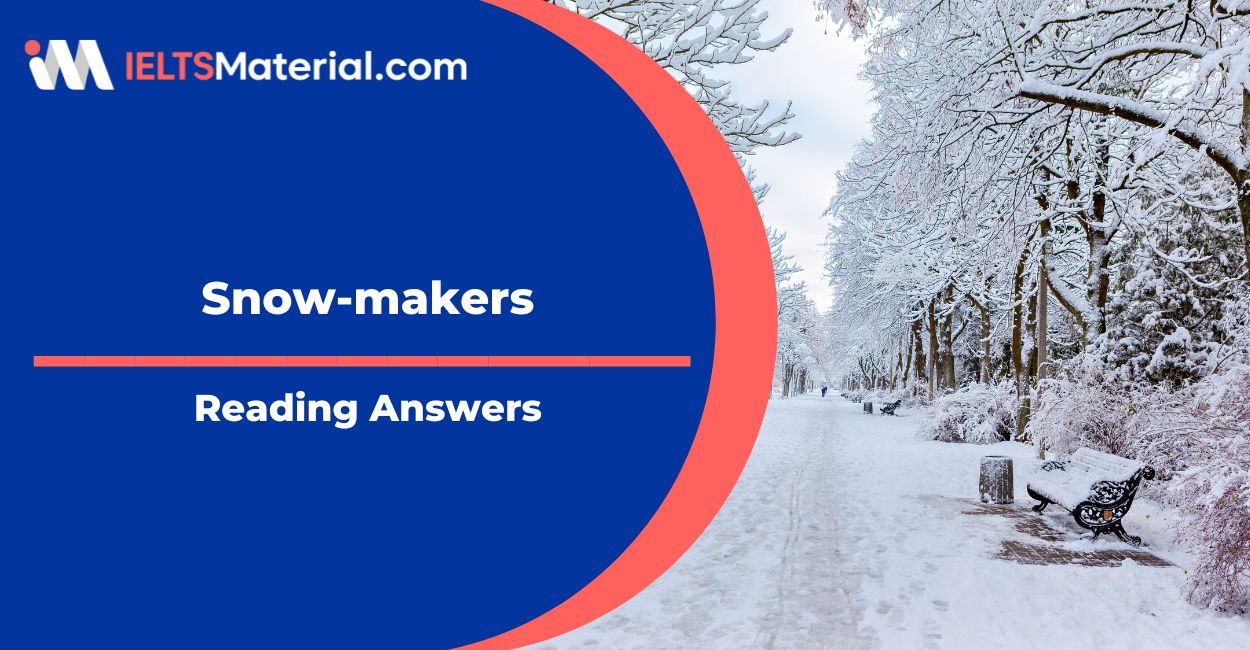Snow-makers Reading Answers
7 min read
Updated On
-
Copy link
Table of Contents

Limited-Time Offer : Access a FREE 10-Day IELTS Study Plan!
This article contains the Snow-makers reading answers.
Snow-makers is a real Reading test passage that appeared in the IELTS.
With diligent practice, the Reading Module can be the top-scoring category for IELTS Aspirants. To score well, you must understand how to approach and answer the different question types in the Reading Module.
By solving and reviewing Sample Reading Questions from past IELTS papers, you can ensure that your Reading skills are up to the mark. Take the practice test Snow-makers below and try more IELTS reading practice tests from IELTSMaterial.com.
Not sure how to answer IELTS Reading Matching Headings questions? Check out the video below for the latest tips and strategies!
For more Sentence Completion practice, take a look at IELTS Reading Sentence Completion Example 1!
Snow-makers
You should spend about 20 minutes on Questions 1-13, which are based on the Reading Passage below. Find the practice test with the Snow-makers PDF here.
Questions 1-5
Reading Passage 285 has seven paragraphs A-G.
Choose the correct heading for each paragraph from the list of headings below.
Write the correct number (i-x) in boxes 1-5 on your answer sheet.
Example Answer
Paragraph A v
Paragraph B x
- Paragraph C
- Paragraph D
- Paragraph E
- Paragraph F
- Paragraph G
List of headings
i Considering ecological costs
ii Modifications to the design of the snow gun
iii The need for different varieties of snow
iv Local concern over environmental issues
v A problem and a solution
vi Applications beyond the ski slopes
vii Converting wet snow to dry snow
viii New method for calculating modifications
ix Artificial process, natural product
x Snow formation in nature
Questions 6-8
Label the diagram below.
Choose NO MORE THAN TWO WORDS from the passage for each answer.
Write your answers in boxes 6-8 on your answer sheet.

Questions 9-13
Complete the sentences below.
Choose NO MORE THAN THREE WORDS from the passage for each answer.
Write your answers in boxes 9-13 on your answer sheet.
- Dry snow is used to give slopes a level surface, while wet snow is used to increase the …………….. on busy slopes.
- To calculate the required snow consistency, the …………….. of the atmosphere must first be measured.
- The machinery used in the process of making the snow consumes a lot of …………….. which is damaging to the environment.
- Artificial snow is used in agriculture as a type of …………….. for plants in cold conditions.
- Artificial snow may also be used in carrying out safety checks on ……………..
Answers
| Question Number | Answer | Explanation |
|---|---|---|
| 1. | ix | In paragraph C, the writer says “The snow gun works very differently from a natural weather system, but it accomplishes exactly the same thing. The device basically works by combining water and air. Two different hoses are attached to the gun. one leading from a water pumping station which pumps water up from a lake or reservoir, and the other leading from an air compressor. When the compressed air passes through the hose into the gun. it atomises the water – that is, it disrupts the stream so that the water splits up into tiny droplets. The droplets are then blown out of the gun and if the outside temperature is below 0°C, ice crystals will form, and will then make snowflakes in the same way as natural snow.” Here different from natural refers to artificial. This paragraph talks about the snow gun which is an artificial process used to atomise natural products like water. Hence the appropriate heading would be ix (Artificial process, natural product) |
| 2. | iii | In paragraph D, the author pinpoints that “Snow-makers often talk about dry snow and wet snow. Dry snow has a relatively low amount of water, so it is very light and powdery. This type of snow is excellent for skiing because skis glide over it easily without getting stuck in wet slush. One of the advantages of using a snow-maker is that this powdery snow can be produced to give the ski slopes a level surface. However, on slopes which receive heavy use, resort owners also use denser, wet snow underneath the dry snow.” This paragraph talks about the need for different varieties of snow. Hence the appropriate heading would be iii (The need for different varieties of snow) |
| 3. | viii | In paragraph E, the writer pinpoints that “Many ski slopes now do this with a central computer system that is connected to weather-reading stations all over the slope.” Here, reading refers to calculating. This paragraph talks about the new method for calculating weather. Hence the appropriate heading would be viii (New method for calculating modifications). |
| 4. | i | In paragraph F, the author tells that “But man-made snow makes heavy demands on the environment. It takes about 275,000 litres of water to create a blanket of snow covering a 60×60 metre area. Most resorts pump water from one or more reservoirs located in low-lying areas. The run-off water from the slopes feeds back into these reservoirs, so the resort can actually use the same water over and over again. However, considerable amounts of energy are needed to run the large air-compressing pumps, and the diesel engines which run them also cause air pollution.” and heavy demands refer to the costs. This paragraph talks about the various ways manmade snows costs the ecology. Hence the appropriate heading would be I (Considering ecological costs) |
| 5. | vi | In paragraph G, the author says “But man-made snow has a number of other uses as well. A layer of snow keeps a lot of the Earth’s heat from escaping into the atmosphere, so farmers often use man-made snow to provide insulation for winter crops. Snow-making machines have played a big part in many movie productions. Movie producers often take several months to shoot scenes that cover just a few days. If the movie takes place in a snowy setting, the set decorators have to get the right amount of snow for each day of shooting either by adding man-made snow or melting natural snow. And another important application of man-made snow is its use in the tests that aircraft must undergo in order to ensure that they can function safely in extreme conditions.” Here, ‘uses’ refer to the applications and ‘man-made’ snow means ski slopes. This paragraph talks about the various applications of ski slopes. Hence the appropriate heading would be vi (Applications beyond the ski slopes) |
| 6. | compressed | In paragraph C, the author states that “When the compressed air passes through the hose into the gun….” From the diagram and the information in the text, we can infer that it is compressed air. Hence the answer is compressed. |
| 7. | droplets | In paragraph C, the writer states that “When the compressed air passes through the hose into the gun. it atomises the water – that is, it disrupts the stream so that the water splits up into tiny droplets.” From the diagram and the information in the text, we can infer that water is atomised into tiny droplets. Hence the answer is tiny droplets. |
| 8. | Ice crystals | In paragraph C, it is said that “The droplets are then blown out of the gun and if the outside temperature is below 0°C, ice crystals will form, and will then make snowflakes in the same way as natural snow.”
From the diagram and the information in the text, we can infer that ice crystals are formed. Hence the answer is ice crystals. |
| 9. | depth | In paragraph D, it is given that “Many resorts build up the snow depth this way once or twice a year, and then regularly coat the trails with a layer of dry snow throughout the winter.” This is paraphrased in the sentence as, “Dry snow is used to give slopes a level surface, while wet snow is used to increase the depth on busy slopes.” Hence the answer is depth. |
| 10. | Temperature and humidity | In paragraph E the author mentions that, “The wetness of snow is dependent on the temperature and humidity outside, as well as the size of the water droplets launched by the gun. Snow-makers have to adjust the proportions of water and air in their snow guns to get the perfect snow consistency for the outdoor weather conditions.” This is paraphrased in the sentence as, “To calculate the required snow consistency, the temperature and humidity of the atmosphere must first be measured.” Hence the answer is temperature and humidity. |
| 11. | energy | In paragraph F, the author says that’ “However, considerable amounts of energy are needed to run the large air-compressing pumps, and the diesel engines which run them also cause air pollution.” Here, ‘large air-compressing pumps, and the diesel engines’ refer to ‘machinery’, Cause air pollution means the same as ‘damaging the environment.’ The machinery used in the process of making the snow consumes a lot of energy which is damaging to the environment.” Hence the answer is energy. |
| 12. | insulation | In the last paragraph, the writer mentions that “A layer of snow keeps a lot of the Earth’s heat from escaping into the atmosphere, so farmers often use man-made snow to provide insulation for winter crops.” Here, ‘man-made’ means ‘artificial’ and ‘winter crops’ refer to ‘agriculture’. This is paraphrased in the sentence as, “Artificial snow is used in agriculture as a type of insulation.” Hence the answer is insulation. |
| 13. | aircraft | In the last paragraph, the writer says that, “And another important application of man-made snow is its use in the tests that aircraft must undergo in order to ensure that they can function safely in extreme conditions.” Here, ‘man-made’ means ‘artificial’, ‘undergo’ means to ‘carry out’ and ‘ensure’ means to ‘check’. This is paraphrased in the sentence as, “Artificial snow may also be used in carrying out safety checks on aircraft”. Hence the answer is aircraft. |
Check More IELTS Reading Answers
Also check :
Practice IELTS Reading based on question types

Start Preparing for IELTS: Get Your 10-Day Study Plan Today!
Recent Articles

Nehasri Ravishenbagam

Haniya Yashfeen

Haniya Yashfeen

Haniya Yashfeen




Post your Comments